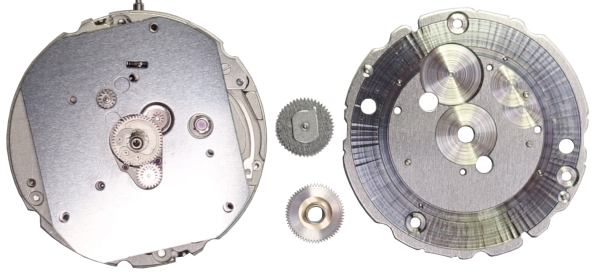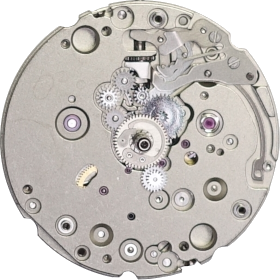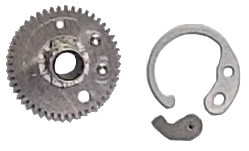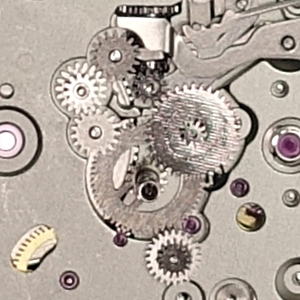Around mid-2022, the first watches with the Japanese Miyota 9075 with a true GMT function appeared on the market. Such a movement had been expected for some time, but Miyota had not made a press fuss about it in advance.

In a true GMT display, the minute hand and the second hand belong to the 24 h hour hand, while the date switching belongs to the normal hour hand. The normal hour hand shows the local time, the 24 h hour hand shows the local time at home.
The hour hand can usually only be adjusted in units of full hours relative to the 24 h hour hand. On true GMT movements, you can therefore adjust the normal hour hand and thus also the date, while the minute, second and 24-hour hands continue to run. This is handy for quickly adjusting the local time when traveling. The date here even switches backwards when you turn the hour hand back over the date line.
If you want to know a bit more about different GMT variants, you will find it here (sorry, only available in German): How a GMT display works Part 1 – Basics

The Miyota 9075, which we will take a look at in a moment, comes from this watch, but we won’t deal with it further here:

The green hand is the 24 h hour hand, for which there is also a 24 hour scale on the dial.
The base movement of the Miyota 9075 is the Miyota 9015, which I described in detail here: Inside the Miyota 9015 (sorry, only available in German).
Before we get into the inner part of the movement, let’s first take a look at the technical specifications of the Miyota 9075:
- Display of hours with true GMT function, minute, center second (hacking), date, 24 h display
- No date quickset, but semi quickset via hour jumps of the GMT function
- Automatic, unidirectional winding, manual winding possible
- Diameter 11 1/2´´´ (French lines) = 26 mm, height approx. 4.95 mm
- 28,800 vibrations/hour
- Power reserve approx. 42 hours
- Lever escapement
- 24 jewels
- Glucydur balance
- Shock protection Citizen Parashock
- Lifting angle 51°
On the bridge side, the Miyota 9075 and the 9015 are identical, except for the inscription on the rotor. The differences can be found on the dial side, which we focus on here. For comparison, the next picture shows the dial sides of the Miyota 9015 (left) and the 9075 (right):

The additional GMT function of the 9075 increases its height by about 1 mm compared to the base movement.
So, let’s remove the date covering plate and the date disc of the 9075:

Not very exciting, since there is another cover plate underneath. Also, in the center, the hour wheel for the 24 h display, which is apparently driven by a small connecting wheel. And above the 24 h hour wheel, a date driving wheel, which switches the date disk with its small spike.
Okay, now let’s remove the cover plate that is fixed with three large screws. Hooray, there is another cover plate underneath, but it is only laid on top:

The 24 h hour wheel in the center has already been removed here. Below it is the hour wheel for the normal hour hand. The date driving wheel was also removed, on the left above the hour wheel, you can see the small wheel that drives it.
After removing this cover plate as well, we finally have a clear view of the motion works:

Here’s a warning right away, in case you disassemble a Miyota 9075 yourself: the hour wheel in the middle carries a small click and a click spring, which only rest on the hour wheel.

If you try to adjust the hour hand via the GMT function in this partially disassembled state of the movement, the click and the click spring will most likely become detached and fly across the room! Only if the cover plate with the three large screws is in place, these parts are secured.
The following picture shows the movement with the hour wheel removed. In the center, you can now see the indirectly driven center wheel.

In addition to the click shown above, the hour wheel has another special feature, namely two gear wheels arranged one above the other:

Strictly speaking, the hour wheel consists of two parts that are inserted into each other, each with a gear rim. The small click ensures that when the upper gear rim is turned, the lower one is also turned. When the lower gear rim is turned, the upper one does not move. The axle for the hour hand is connected to the lower gear rim. This difference is essential for the GMT function, i.e. setting the hour hand in full hour increments.
Let’s now take a closer look at the motion works using the following numbering:
- Setting wheel
- Minute wheel for normal hour wheel (3)
Its pinion engages in the upper gear rim of (3) - Hour wheel (above this is the 24h wheel)
- Intermediate wheel
Does not touch 1 when the crown is fully pulled, otherwise it does - Connecting wheel for date driving wheel (lies one level higher)
- Another intermediate wheel
Engages in the lower gear rim of the hour wheel (3) - Minute wheel for 24h wheel
Normal time setting (crown fully pulled out):
And this is how it works:

The setting wheel 1 turns the minute wheel 2 and its pinion turns the upper gear rim of the hour wheel 3. Wheels 1 and 4 do not touch each other. The 24-hour hand moves synchronously via the minute wheel 7 for the 24h wheel during setting. The lower gear rim of the hour wheel 3 drives the wheels 6 and 5 so that the date changes accordingly. Wheel 4 simply rotates freely.
Here, the hour hand and the 24 h hand are set together so that they always keep the same time difference from each other, if one was previously set via the GMT function. The GMT function (hour jumps) itself plays no role when setting hands!
Setting the time zone ( middle crown position) / GMT function:
And this is how it works:

The setting wheel 1 has no contact with the minute wheel 2, but with the intermediate wheel 4. Via the wheels 5 and 6 it turns the lower gear rim of the hour wheel 3, which only allows the hour hand to jump by full hours because of the click. The 24-hour hand is not turned because the minute wheel 7 for the 24h wheel engages the upper gear rim of 3, which does not move here.
The date is also moved forward or backward via the change wheel 5.
This means that the date can also be adjusted semi-fast, as there is no extra quick setting for this!
The implementation of a true GMT function is therefore not that technically complex! It is all the more surprising that many watch brands only offer a true GMT function in high-priced models, if at all. On the other hand, the clientele interested in a GMT function is probably also limited.

Thank you for the detailed analysis!
Do you happen to know if the date wheels between the 9015 and 9075 are compatible? I have a 9015 movement with a date wheel at 6 (that aligns properly with a dial), but I cannot make that same date wheel align at 6 when installed on the 9075. It’s always in between 2 dates if the spring is to properly alight between the date wheel teeth.
I’m not sure if I’m missing something when installing it, or if the angle at which it needs to be printed is different between the 9015 and 9075…
Thanks!
Unfortunately, I have no information on this. The date disc at least has different part numbers for the 9015 and 9075. So it looks like they are different.
Thank you for this great explanation! There’s only one thing I don’t understand: “The small click ensures that when the upper gear rim is turned, the lower one is also turned. When the lower gear rim is turned, the upper one does not move.”. How exactly does the click ensure that and why does the upper gear not move when the lower gear is turned?
Probably it’s simpler than you think. The click engages with one of the gear rims. The shape of the click ensures that the gear rim can rotate in one direction. It is blocked in the other direction by the click.
Fantastic disassembly! Looks more premium than the NH34! The 9075 doesn’t have any plastic parts right? I saw a disassembly of the NH34 movement and it had a lot of plastic gears in it.
Is the 9075 stem type and tap same as 9015?
9075 tap looks larger to me. Please could you confirm?
Yes, it’s the same stem.